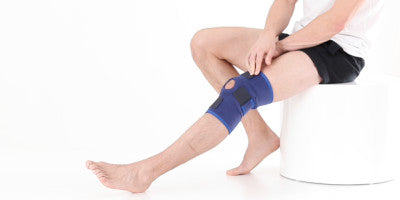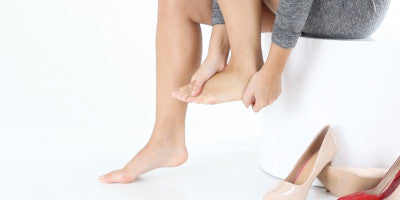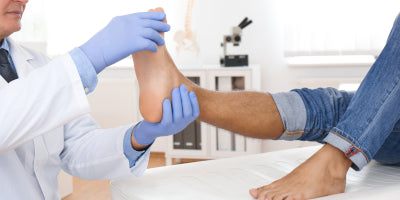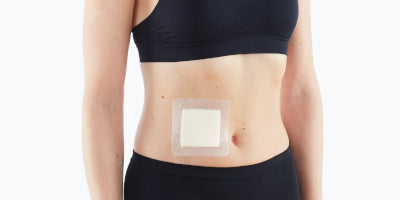What Can Help Scars Heal Faster?

Scars are a natural and final part of the body's healing process, however there are things we can do to help their progression. Whether from surgery, injury, acne, or other skin conditions, scars can be a source of physical discomfort and emotional distress. Understanding the science behind scar formation and the factors that influence healing can empower us to take effective steps towards smoother, healthier skin.
What are scars and what causes scars to form?
Understanding what scars are and why they form is crucial for anyone looking to effectively manage and minimize their appearance, as it provides the foundation for choosing the most appropriate treatment methods.
Scars are areas of fibrous tissue that replace normal skin after an injury. They are the body's natural way of healing and protecting itself following damage to the dermis, the deep, thick layer of skin. When the skin is injured, the body initiates a complex process to repair the wound. This involves the formation of new collagen fibres, a protein that provides strength and structure to the skin. While this repair mechanism is effective, it doesn't always result in a perfect restoration of the original tissue. Instead, the new tissue has a different texture and quality, leading to the formation of a scar.
The formation of a scar is influenced by several factors, including the depth and size of the wound, its location on the body, and an individual's age and genetic predisposition. Deeper and larger wounds tend to produce more pronounced scars because they require more extensive repair. The healing process is also affected by how well the wound is cared for; infections or repeated trauma can exacerbate scarring. Additionally, certain areas of the body, like the chest and back, are more prone to developing thicker, more noticeable scars due to the higher tension in these regions. Genetics play a crucial role as well; some people are more prone to developing hypertrophic scars or keloids, which are raised and can grow beyond the boundaries of the original wound.
While it is impossible to completely eliminate a scar, it is important to understand that scars will naturally fade over time. Most wounds, except for very minor ones, result in some degree of scarring. The process of scar maturation typically takes between 6 to 18 months, during which the scar will gradually become less noticeable. Initially, scars may appear red, raised, or dark, but as they progress through the Remodelling Phase, they often flatten, lighten, and soften. The final appearance of a scar is influenced by several factors, including the type of injury, the location on the body, and how well the scar was cared for during the healing process. For example, a deep cut or burn may result in a more prominent scar compared to a minor scrape. Additionally, proper wound care, such as keeping the area clean, moisturized, and protected from the sun, can significantly improve the outcome. This raises the question: can you prevent a scar? While it is not possible to entirely prevent scar formation, taking proactive steps during the initial healing stages can minimize their severity and enhance their final appearance. Techniques such as using silicone scar strips, massaging the area with a suitable cream, and avoiding sun exposure can all contribute to better scar management and a more aesthetically pleasing result.
What are the types of scars?
Scars can manifest in various forms, each with distinct characteristics and underlying causes. Among the most common types are keloid scars and hypertrophic scars, both of which involve an overproduction of collagen but differ significantly in their behaviour and appearance.
Keloid Scars
Keloid scars are thick, raised scars that extend beyond the boundaries of the original wound. They occur when the body continues to produce collagen after the wound has healed, leading to a mass of scar tissue that can grow indefinitely. Keloids are often shiny, have a smooth surface, and can be red or darker than the surrounding skin. They may be accompanied by symptoms such as itching, tenderness, or pain. Keloids are more prevalent in individuals with darker skin tones and are commonly found on areas like the chest, shoulders, earlobes, and cheeks. They can form after minor injuries such as cuts, burns, surgical incisions, or even acne, and tend to be resistant to treatment, often requiring a combination of therapies including corticosteroid injections, laser treatments, or surgical removal.
Hypertrophic Scars
Hypertrophic scars, while also raised and thick, differ from keloids in that they remain confined within the boundaries of the original wound. They result from an excessive accumulation of collagen at the site of injury, leading to a raised, often red and firm scar. Unlike keloids, hypertrophic scars generally improve over time, becoming flatter and less noticeable, although they may take months or even years to do so. These scars are commonly seen after surgical incisions, burns, or other significant skin traumas and are more likely to develop in areas of high tension, such as the shoulders, knees, and elbows. Treatments for hypertrophic scars include silicone gel sheets, pressure therapy, and steroid injections, which can help reduce their size and improve their appearance.
Atrophic Scars
Atrophic scars are characterized by a sunken or depressed appearance, often resulting from conditions that destroy underlying supportive structures like fat or muscle. Common examples of atrophic scars include those caused by severe acne or chickenpox. These scars occur when the body produces insufficient collagen during the healing process, leading to a loss of tissue. Treatments for atrophic scars often focus on stimulating collagen production and can include chemical peels, microdermabrasion, laser therapy, and dermal fillers. These procedures help to raise the depressed areas and improve skin texture.
Contracture Scars
Contracture scars are a type of scar that often results from burns. They occur when the skin "contracts" or tightens as it heals, which can pull the skin and affect underlying muscles and tendons. This can lead to restricted movement and even physical deformities if the scars are severe. Contracture scars can be particularly problematic if they form over joints, limiting the range of motion. Treatments for contracture scars typically involve physical therapy to improve mobility, along with surgical options such as skin grafts or flaps to release the tightened skin and improve function and appearance.
Understanding the differences between keloid, hypertrophic, atrophic and contracture scars is essential for determining the most effective treatment strategy. While they all involve excessive collagen production, their growth patterns and responses to treatment vary significantly, necessitating tailored approaches to achieve the best possible outcomes.
What is collagen?
Collagen is a vital protein in the body, serving as a primary building block not only for skin but also for bones, muscles, tendons, ligaments, organs, blood vessels, and the intestinal lining. In the context of scars, collagen plays a crucial role in the wound healing process. When the skin is injured, the body produces collagen to repair the damage, creating a scaffold that helps rebuild the skin tissue. This new collagen forms a fibrous network that strengthens the wound site, but it also results in the formation of scar tissue. Unlike the organized and elastic collagen in healthy skin, the collagen in scars is arranged in a disorganized, dense pattern, making the scar tissue less flexible and more rigid.
Collagen is made from amino acids, the building blocks of proteins. The main amino acids that make collagen are proline, glycine, and hydroxyproline. These amino acids contribute to the strength and structure of the collagen fibres. The amount and type of collagen produced during the healing process significantly influence the scar's appearance, texture, and size. Understanding collagen's role and its amino acid composition is key to developing treatments that can modulate its production and arrangement, potentially leading to less noticeable scars.
As we age, the natural production of collagen in our bodies decreases, which has significant implications for our skin's ability to heal. Collagen provides structure and strength to our skin and it plays a crucial role in the wound healing process by creating a scaffold that helps rebuild the skin tissue. However, with reduced collagen levels, our skin's elasticity and resilience diminish, leading to slower healing times and a higher likelihood of prominent scarring. This decrease in collagen can exacerbate the formation of different types of scars, including keloid, hypertrophic, atrophic, and contracture scars. For instance, contracture scars, which often result from burns and can severely restrict movement, may become more problematic and harder to treat as the skin's capacity to regenerate is compromised. Understanding the impact of aging on collagen production is essential for developing effective scar treatment strategies, as older skin may require more intensive therapies and prolonged care to achieve optimal healing and minimize scarring.
Can you improve the appearance of scars?
You can improve the appearance of scars through various methods and proactive care. One effective technique is to gently massage your scar with a water-based cream, such as E45 Cream, a few times a day for up to 10 minutes each time. This should only be done once the wound is fully closed, as massaging too soon can disrupt the healing process. Massage helps to break down excess collagen and promotes blood flow, which can soften and flatten the scar.
Additionally, protecting your scar from the sun is crucial, as UV exposure can darken the scar and make it more noticeable. For at least one year, try to keep your scar covered when you're in the sun by wearing clothing that covers it or by applying a dressing. Moreover, using a suncream with a sun protection factor (SPF) of 30 or more on your scar can help prevent discoloration and promote a more even skin tone.
Another highly effective treatment is the use of silicone scar strips. These adhesive strips can be placed directly over the scar and worn for extended periods, often recommended for several hours a day. Silicone strips help to hydrate the scar tissue, reduce collagen production, and create a more favourable environment for scar healing. Consistent use of silicone strips can significantly flatten and soften raised scars, making them less visible over time. However, it's important to note that silicone scar strips are primarily effective for keloid and hypertrophic scars, and may not provide the same benefits for other types of scars such as atrophic or contracture scars.
Why does silicone help scars?
Silicone scar strips offer an effective solution for scar management due to their unique construction and properties. Numerous clinical studies have demonstrated their significant impact on improving both hypertrophic and keloid scars.
Silicone scar strips, such as our Opti-Heal Silicone Scar & Wound Recovery Strips, are an effective treatment for improving the appearance of scars. Constructed from silicone and featuring a low-irritation silicone adhesive, these strips are designed for gentle removal, minimizing pain and trauma to the skin. Translucent in design, they allow for easy monitoring of the affected area as it heals. The soft silicone material conforms to the body for added comfort, making them suitable for sensitive skin. With good adhesion and showerproof properties, these scar reducers offer both short and long-term benefits, providing lasting wear and protection from dirt and germs.
How do silicone scar sheets work?
Opti-Heal Silicone Scar & Wound Recovery Strips work best when you make sure that the strip is sized appropriately for the wound or scar, with a recommended excess of ½ inch around it. The strips can be trimmed to fit the specific size required, and holes may be cut into the material to accommodate fingers or toes.
Before and after use, ensure hands are thoroughly washed. Clean and dry the area of application gently. Remove the strip from its wrapper, taking care to preserve the backing film for future use. Place the adherent side of the strip against the wound or scar without stretching it.
Keep the strip in place for at least 12 hours, with the option to wear it for up to 23 hours per day. If additional support is needed, consider using tape, netting, or a pressure garment to secure the strip in place.
To allow the skin to adjust, begin by wearing the strip for 4 hours daily during the first two days, gradually increasing the duration by 2 hours each day until reaching the optimal therapy time.
When the strip shows signs of deterioration or becomes difficult to clean, replace it. Each strip should not be used for longer than 28 days. Consistent use of the strip over 2 to 4 months typically yields positive healing effects.
How to wash silicone scar sheets
That’s right! You can wash Opti-Heal Silicone Scar & Wound Recovery Strips to get further use out of them. To maintain the effectiveness and longevity of silicone scar strips, proper cleaning is essential for reuse, with each strip lasting up to 28 days, providing a total of 84 days of scar coverage per pack.
Begin by rinsing the product thoroughly with clean, warm water, ensuring all traces of soap are removed. It's advisable to use a fragrance-free soap to avoid any potential skin irritation. After washing, allow the strip to air dry or gently pat it with a lint-free towel before reapplying it to the affected area. Twice daily, remove the strip and cleanse both the affected area and both sides of the product with plain soap and clean warm water. Avoid using soaps containing moisturizers, lotions, or oils, as these can interfere with the strip's adhesive properties. Rinse the strip thoroughly after cleaning and ensure it is completely dry before reuse. Between uses, store the strip on the backing film provided.
With proper care, each strip can be washed and reused for up to 28 days, offering an economical and sustainable solution for scar management. At just £0.12 per day of use, compared to up to £2.14 per day of use for alternative solutions, the Neo G Silicone Scar & Wound Recovery Strips offer exceptional value for money, providing 84 days of scar coverage in each pack.
Managing and improving the appearance of scars involves a multifaceted approach that combines proper care, consistent treatment, and the use of effective products like silicone scar strips. By understanding the different types of scars and their unique characteristics, individuals can tailor their treatment plans to achieve optimal results. Through gentle massage, sun protection, and the use of silicone scar strips, scars can be softened, flattened, and made less noticeable over time. Moreover, the affordability and sustainability of silicone scar strips make them an accessible option for long-term scar management. With dedication and patience, individuals can take proactive steps towards smoother, healthier skin, reclaiming confidence and comfort in their own bodies.



















